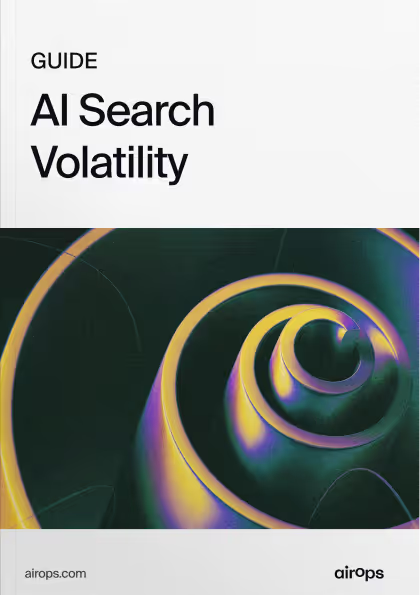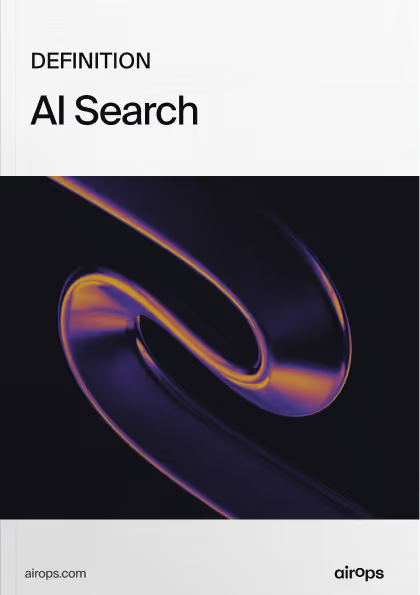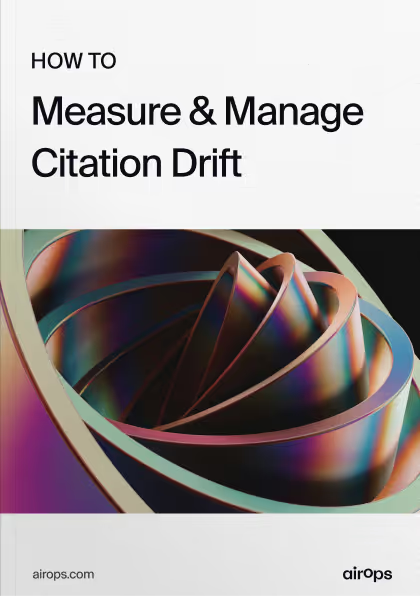AI Search Volatility: Why Brand Visibility Constantly Fluctuates in Answer Engines

- AI search volatility refers to frequent, unpredictable changes in how and when your brand appears in AI-generated answers across platforms like ChatGPT, Perplexity, and AI Overviews
- Technical factors like embedding updates, retrieval methods, and context window limitations combine with competitive dynamics to create constant flux in visibility
- As a result of how volatile AI search is, brands need continuous monitoring to maintain stable presence in AI search results
- AI search volatility refers to frequent, unpredictable changes in how and when your brand appears in AI-generated answers across platforms like ChatGPT, Perplexity, and AI Overviews
- Technical factors like embedding updates, retrieval methods, and context window limitations combine with competitive dynamics to create constant flux in visibility
- As a result of how volatile AI search is, brands need continuous monitoring to maintain stable presence in AI search results
- AI search volatility refers to frequent, unpredictable changes in how and when your brand appears in AI-generated answers across platforms like ChatGPT, Perplexity, and AI Overviews
- Technical factors like embedding updates, retrieval methods, and context window limitations combine with competitive dynamics to create constant flux in visibility
- As a result of how volatile AI search is, brands need continuous monitoring to maintain stable presence in AI search results
- AI search volatility refers to frequent, unpredictable changes in how and when your brand appears in AI-generated answers across platforms like ChatGPT, Perplexity, and AI Overviews
- Technical factors like embedding updates, retrieval methods, and context window limitations combine with competitive dynamics to create constant flux in visibility
- As a result of how volatile AI search is, brands need continuous monitoring to maintain stable presence in AI search results
Brands are already seeing their presence in AI search shift from one day to the next.
This constant fluctuation—what we call AI search volatility—is now a defining challenge for gaining visibility in answer engines.
Unlike traditional SEO, where rankings shift gradually over time, AI search results can change from one query to the next. These fluctuations are not only about whether your brand appears, but also how it’s positioned, which competitors share the same space, and whether your brand earns a citation, a mention, or no visibility at all.
What Is AI Search Volatility?
AI search volatility is the frequent change in how brands or entities are surfaced, positioned, or cited in AI-generated answers.
This volatility affects three main dimensions:
- Appearance frequency: how often a brand or entity is mentioned in the LLMs response.
- Positioning quality: whether the brand or entity is framed as the primary(first) option, one of several, or a secondary alternative.
- Citation strength: whether the brand or entity receive a link, a mention without a link, or a citation is omitted entirely.
Whereas Google rankings may drift incrementally, AI responses can swing between different sources, reasoning paths, or recommendations from one search to the next, even with the exact same query.
What Causes Volatility in AI Search?
Volatility in AI search arises from a mix of technical, contextual, and competitive factors, with model design and algorithmic choices influencing how responses vary.
Model Updates and Retraining
AI models are regularly updated to improve accuracy, safety, and coverage. Each update can subtly shift how queries are interpreted, which sources are prioritized, and how authority is evaluated. These changes may cause a brand that once appeared consistently to see its visibility fluctuate, even if the brand hasn't made any updates to its own content.
Additional technical factors that contribute to volatility during model updates include:
- Embedding model changes that alter how content similarity is calculated
- RAG system updates that change how content is chunked and retrieved
- Adjustments to similarity thresholds that determine what qualifies as relevant
- Changes in how content is converted to vectors for semantic search
Real-Time Retrieval Methods
Many AI platforms combine static training data with live retrieval, which introduces variability into results. Several factors play a role:
- Crawl timing: how quickly new or updated content from your site is indexed.
- Source selection: which domains the system chooses to pull from when generating a response.
- Cache cycles: whether the model is referencing refreshed data or relying on stored versions.
Because these retrieval methods can change between runs, the same query may surface different sources and response behavior, even within the same conversation.
The technical architecture behind retrieval also creates volatility through:
- Context window limitations that restrict how much content can be processed at once
- Token budget allocation that varies based on system load and query complexity
- Dynamic retrieval counts that change how many sources are fetched
- Different tokenization rates for technical versus simple content
Web Search Settings and Capabilities
AI platforms differ in how much they rely on live web retrieval versus training snapshots. In many cases, the model itself decides whether to fetch fresh data based on the query type. For example, a question about breaking news is more likely to trigger a live search, while evergreen topics may default to training data.
In addition, some platforms allow users to manually enable or disable web search. This creates another layer of variability, since the same query can return very different results depending on whether real-time retrieval is active.
As a result, two people asking the same question may see different answers depending on query classification, user settings, subscription tiers, or how the model chooses to pull data.
User Context and Search Behavior
AI systems don't just interpret queries in isolation—they often adapt responses based on the user's context and activity, especially when the user is logged in. This means two people asking the same question can receive noticeably different answers, based on user personalization.
Several factors that can influence these shifts include:
- Search history and patterns: previous queries can shape which brands or categories are emphasized.
- Conversation flow: starting a new query versus continuing an existing thread can shift how the model interprets intent, since prior exchanges may shape its contextual understanding.
- Language style: casual phrasing (e.g., "what's a good CRM?") may surface broad, consumer-friendly options, while technical phrasing (e.g., "enterprise CRM deployment options") may highlight specialized or enterprise-focused tools.
- Timing and system load: the time of day or server conditions can influence which sources are retrieved.
While these context signals make results more dynamic and tailored for users, they also introduce additional complexity and unpredictability for brands trying to manage visibility in volatile AI search environments.
Geographic and Regional Variations
The location where a user submits a query can influence how an LLM shapes its response. Contributing factors may include localized query handling, prioritization of region-specific sources, or adjustments made to reflect regional context.
Key factors include:
- Local brand prioritization: a query like "best accounting software" in London may feature UK vendors, while the same query in New York highlights US companies.
- Currency and market relevance: pricing references or case studies may be localized to the user's region.
- Data access and restrictions: some sources may be deprioritized or unavailable due to legal frameworks (such as GDPR) or technical barriers.
- Language and model versions: responses may differ depending on localization, translation handling, or model deployment across regions.
- Cultural context: business practices and consumer norms can shape which examples or solutions are highlighted.
This can cause shifts in visibility across regions, where a brand may appear prominently in one market but be absent in another. In these instances, it may not always be due to relevance but instead the way AI platforms account for regional factors.
Query Intent Signals
The intent behind a query—whether someone is seeking background information, comparing options, or preparing to purchase—can strongly influence how AI systems construct their answers. Models attempt to interpret that intent and adjust what they surface accordingly.
- Informational queries: broad questions may return definitions, explanations, or general concepts rather than specific brands.
- Comparative or transactional queries: phrasing that suggests evaluation or purchase intent may introduce vendors, pricing details, or product recommendations.
- Modifiers: small changes such as adding a year, including "for small business," or using industry-specific terms, can influence whether the model leans on training data or performs web-based retrieval.
Since interpretation isn't always consistent, intent introduces one of the most variable dimensions of AI search. A subtle change in phrasing may cause a brand to appear prominently, shift in context, or disappear from the results altogether.
Training Data Cutoffs and Gaps
AI models vary in how and when they are trained, which creates differences in what each system "knows." Some rely primarily on static snapshots of the web, while others incorporate more frequent updates or supplement with third-party data sources.
Content published after a model's last training cycle may not appear unless the platform also retrieves live web information.
Recent research from AirOps found that content refreshed within the last 90 days were significantly more likely to appear in generative results compared to older, static content.
When static training data is blended with real-time retrieval, results can vary widely across platforms, or even within the same platform—leading to uneven visibility for brands.
Competitive Content Changes
A brand's visibility in AI search is shaped not only by its own content and authority but also by what competitors publish. A new research report, media mention, or site update from another brand in the category may shift which sources an AI system pulls into its answers.
In competitive markets, this constant stream of activity can influence how often—and in what context—your brand appears, adding another layer of volatility to AI search.
In a recent study at AirOps, we found that around 30% of brands sustained visibility between consecutive runs, while 57% of pages resurfaced after disappearing—showing how quickly competitor activity and model shifts can replace one brand's visibility with another.
This is why building topical authority matters: brands with consistent depth of coverage across a subject area are more likely to be referenced as reliable sources, helping them maintain visibility even as competitors introduce new content.
Platform-Specific Ranking Factors
AI platforms don't all use the same criteria when generating answers. Each models system weighs signals such as relevance, authority, credibility, and freshness differently—and often apply unique heuristics or ranking frameworks based on their models structure.
Key technical differences between platforms include:
- Response caching strategies that affect how often fresh answers are generated
- Temperature and sampling parameters that control response variability
- Multi-stage inference pipelines that filter content at different points
- Different reranking algorithms that prioritize sources differently
As a result, the same query can produce different citations or brand mentions across platforms like ChatGPT, Perplexity, or Gemini. These differences highlight the importance of monitoring performance across multiple systems, since visibility in one environment doesn't guarantee presence in another.
How Do I Track Shifts in Brand Visibility Across LLMs Over Time?
To track how your brand’s visibility changes across large language models (LLMs) like ChatGPT, Claude, Gemini, and Perplexity, you’ll need to measure Share of Voice (SOV) and citation frequency over time using a consistent query set and dataset. The goal is to see whether your brand is being mentioned, linked, or cited more or less often in AI-generated answers compared to competitors.
Why Pages Disappear from Generative Results
Content that once appeared in AI-generated answers may stop surfacing, even if nothing on the page itself has changed. This can happen for several reasons:
- Model updates: retraining or fine-tuning can change how queries are interpreted or which sources are prioritized.
- Shifts in retrieval: when platforms rely on live web search, newer or alternative sources may displace older content.
- Competitive activity: fresh research, media coverage, or site updates from competitors can push their pages into results instead.
- Training data limits: content published after a model's last training cutoff may not appear unless live retrieval is triggered.
- Authority and topical depth: pages that don't demonstrate strong coverage or expertise of a subject may be replaced by sources with greater topical authority.
- User and contextual signals: differences in query phrasing, personalization, or geography may cause a page to appear for some users but not others.
Technical factors that also contribute to disappearance:
- Embedding space drift as language models evolve
- Context window competition between multiple sources
- Adaptive retrieval strategies that dynamically adjust source counts
- Changes in token efficiency requirements
These factors rarely act in isolation. In most cases, disappearance from generative results reflects a combination of evolving model behavior, retrieval decisions, and competitive shifts—making visibility in AI search inherently dynamic.
What's the Fastest Way to Identify Content Losing Visibility in AI Search?
The quickest way to identify if content is losing visibility in AI search is to track queries over time and compare which pages are being cited, mentioned, or omitted across test runs. Consistent monitoring highlights when a page that once appeared in generative results begins to drop out, helping teams act before visibility losses compound.
How Often Should Content be Updated to Maintain LLM Visibility?
There isn't a fixed update cadence, since visibility depends on how often models refresh, when retrieval is triggered, and how competitive the market is for the queries topic. A practical approach is to review content monthly or quarterly, and prioritize more frequent updates for industries in fast-moving markets.
Volatility Is the New Normal
Volatility is a normal state of AI search environments and is likely to intensify as additional platforms are released and models continue to be updated. Brands that build adaptive strategies will thrive, while those that treat AI search like static SEO will watch their visibility swing wildly without understanding why.
The solution isn't to fight volatility but to embrace it with the right tools and approach.
Ready to scale how your brand is discovered in answer engines? Book a strategy session to see how AirOps helps brands win AI search.
Win AI Search.
Increase brand visibility across AI search and Google with the only platform taking you from insights to action.
Table of Contents
Get the best and latest in growth and AI search delivered to your inbox each week.




